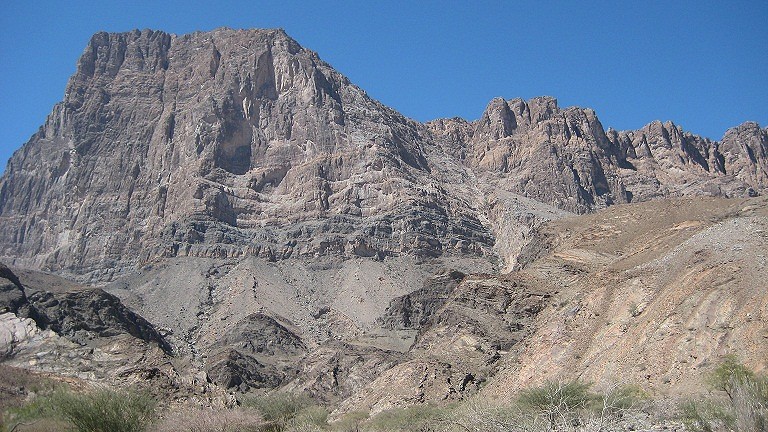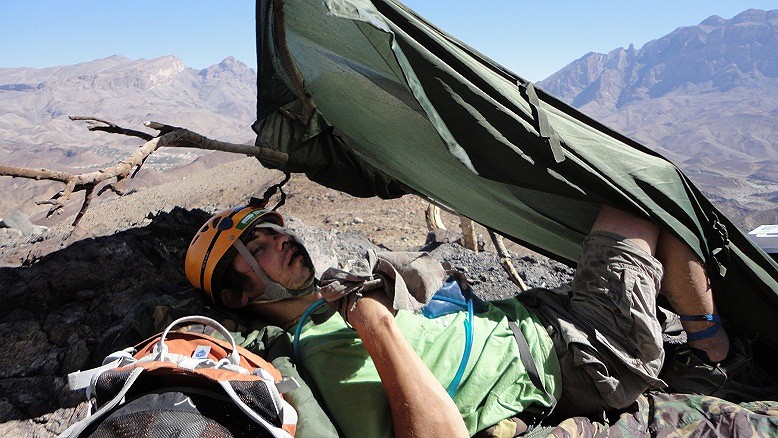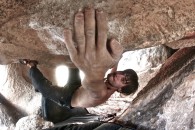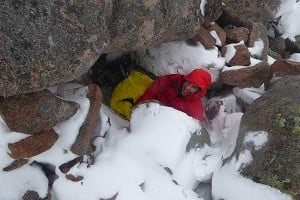
Every climber has that dream route or climbing area that they long to try or visit; it might be a route that is steeped in history, a ground-breaking ascent for the era, or just a great personal challenge. 3 years ago that dream for me was a new route on Jebel Misht in Oman.
Having graduated in May 2011 with a degree I'd lost interest in, the world of climbing was my real passion. Gaining true independence for the first time and having to search for a (real) job led me to becoming a guide in Oman. I had never really known where it was let alone if there was any decent climbing there, but after some research I was wowed by the rock they have available. Oman is located in the Middle East just below the UAE and is more or less made up of 50% desert and 50% mountains, including a 1000m big wall route named Jebel Misht.
It was first climbed back in 1979 by Raymond Renaud in a 'siege' style using fixed ropes and a tactical helicopter for supply drops. The remains of this ascent can still be seen, like a hanging history of climbing with old karabiners, ropes and pitons on ledges along the route. There are rumours that after their ascent in which they covered more than 2 kilometres of climbing, they were airlifted from the summit to the Sultan's palace to celebrate.
This looked like my climbing dream. Having studied all the existing routes up the mountain and started reading up about big wall climbing, I began practising my hauling techniques and training every day. I knew that if I was to do this big wall I wanted to do it in one push, ground to summit in 24 hours. To get some practice and a feel for the rock I started climbing some of the smaller routes that were established around the country; Zizanne is on a large rock outcrop called Al Hamra Towers to the South of Muscat where I was staying. The route we climbed was graded VII+ 5c, and went smoothly; after 300m of ascent and 5 hours we summitted. This was great opportunity to learn the characteristics of the rock and more importantly understand how quickly I would need to climb to summit Misht in a day.
During subsequent time off I tried a number of other climbs – the beautiful Wadi Tiwi boasted 200m-500m routes in a back drop of quiet villages. Juliette Jaufrett, 6b+ TD+, had come highly recommended by friends Larry and Hamza, being 'retro bolted' by a French team some years ago. This in reality meant that it was a sport route with bolts every 10m-20m and bolted belays. I took Trad gear but found this of little help in a rock type that seems to dislike modern protection. 6 hours on the route with me leading every pitch saw us to the summit, and I felt that I understood what Jebel Misht might have in store.
Having a few friends who'd already made hard ascents on Misht including the notoriously difficult Icarus route, I was lucky for Hamza Zidoum to join me for what could be a first ascent. He'd mentioned a new route he had tried before on the East face which tackled a giant overhang but hadn't managed to climb past it. This was to be our line – unknown ground. Hamza sent a few pictures showing how to climb the roof and where to go once we'd overcome it; everything had been planned for.
We arrived at base camp around 6pm – Hamza in a tent and me in my 'light and fast' bivi bag. We had a cup of tea and looked at our route on the wall while basking in the evening sun. By the time dark had come we had racked our equipment, filled our camel backs and had a bite to eat in preparation for the 2 hour hike to the foot of the route the next day.
We awoke early at 3.30am and after another cup of tea and a small breakfast we got our packs together and began hiking up to the bottom of the face. By 6.30am we were at the base of the route looking up at the great roof while also enjoying the beautiful desert sunrise with a snack. We moved together on the first few pitches as the climbing was relatively easy, coming to a large ledge where we could belay. Hamza began, still having the whole rack attached to him and reached another ledge some 50m up. Coming to meet him we realised this pitch could also have been run together, with steady climbing and little need for protection. Another pitch and it came to Hamza's lead again. I had anchored myself to a small ledge some 6m up from a much wider one and Hamza set off. He had placed a few pieces of protection along the way and had just slung a rock and clipped into it when things started going wrong.
While he had been attaching himself to the rock, the ropes had caught under a football-sized chunk that had dislodged and fallen down to where I had been standing. I heard the unforgettable chink of the rock bouncing down and instantly knew what was heading my way. As I looked up I felt an enormous throb in my face followed by weightlessness. I sat up to find the ropes taught and I was lying on the floor with blood all around me. There was a huge flap of skin hanging down from my face and my foot was bleeding heavily. I shouted up to Hamza that I'd been hit and would need him to come help me, whilst trying to stay calm. I untied the ropes and searched for the only part of my med kit I had packed. I had brought just 3 bandages and some rehydration salts - my previous thoughts were if I needed more than 3 I was totally screwed anyway!
I had just got them out my bag when I heard Hamza calling from above to tell me he was heading down, followed by the shout "ROCKKKKK!". Looking up, another large stone similar to that of the first was about to land directly on my forehead. I quickly rolled out the way and it impacted on the floor where I had been sitting, cutting my leg and sending shooting pains down my side. I continued to crawl across the ledge hoping to get out of the fall line of any more rocks that may come loose. Looking again at my injuries I tried to identify the one that needed attention first. Although my face hurt the most it was not going to be fatal. My ankle however was bleeding a lot and my concern was keeping as much of that blood in me as possible. I bandaged my foot, wrapping it tightly to apply pressure and stop the flow of blood on the floor. Hamza arrived at the bottom and began to help me dress my wounds with the hope we would both make it off this mountain alive. We pushed the flap of skin back across my face and held it on with a bandage around my head. With the remaining dressing we placed it around my foot again hoping to stop the blood and keep it clean for when (if!) we reached a hospital.
Knowing there was no mountain rescue in the country we called the next best thing, my boss Rob. We told him the situation and found out he was nearby so was going to head over to get me down with a group of helpers. Failing that he would try to get a helicopter. We were now some 200m up on a big wall with me unable to stop the bleeding completely, and Hamza in the predicament of figuring out how to get us down safely. We had never planned for this; I don't think many people plan for something to go so wrong! I shuffled over to where Hamza had set up an abseil was and we made our way down to another ledge, bouncing down the rock face as I went leaving a blood trail in my wake.

We continued down with not too much difficulty until we came to our original starting ledge. Gathering our food and water we decided to try out this tip I had read somewhere about turning an alpine coil into a person-carrying back pack. After some fidgeting we managed to get me on Hamza's back but after a couple of meters we realised it wasn't such a good idea. If Hamza was to trip he may have fallen off the edge of a 200m drop taking both of us with him and with my useless weight on his back it seemed a likely possibility. I got off and decided I would 'bum shuffle' my way down the mountain. This way of moving was much safer than the back-carrying but was incredibly painful if I caught my foot, not to mention that I was wearing through the seat of my trousers and underwear whilst dragging my now useless body around. After 3 hours of shuffling and roughly 250m of descent later I was exhausted and losing consciousness. Knowing a party of people was on the way I urged myself to continue to a possible helicopter landing point. As we reached the small flat area I lay back and drank as much water as I dared, not knowing how long we would be there.
Thankfully, not long after getting there we saw a figure approaching in the distance. At first we couldn't make out what it was, thinking it could just be one of the local's goats that wonder the hills. As the figure grew nearer we realised it was not a goat but my boss sprinting towards us. What had taken us hours to walk seemed to take him minutes to run and he was soon with us. He took one look and said "we're gonna need a helicopter..." My heart sank thinking how long I might be on the side of this mountain. I was already lying flat out in the boiling midday sun, unable to find shade and still bleeding. Rob produced a sleeping bag and a bottle of water in which we could make a shelter and keep hydrated, then left again saying a helicopter was on its way and would be there in 30 minutes. With his supplies, Hamza created a makeshift shelter to cover us from the sun while I cut off what was left of my trouser-leg to make more bandages to tie around my foot. The wait began.
1 hour passed and it felt like my body had gone through a roller coaster. The pain was slowly increasing but I was trying to keep cool-headed about the situation, knowing that if I panicked it would only makes things worse. After 9 hours of desperately trying to find out when the helicopter was coming, I was mentally and physically exhausted. The baking heat of the day had all but drained my energy and morale. I was becoming so weak I could barely lift myself around and it was beginning to get dark, dashing all my hopes of a helicopter rescue. Yet, by hour 10 we heard helicopter rotors and we both knew it must be the one we had been waiting for.
It came into view but flew straight passed us, not noticing the H landing pad Hamza had laid out in stones or us waving our colourful jackets in the air with our head torches flashing. It then suddenly dawned on me how impossible it must be to see two tiny specks at the bottom of a huge wall even with all the preparation we had done. It continued to fly around while Hamza tried to navigate it towards us by calling the pilot on his mobile. He still couldn't find us and the night was drawing in. I knew if it got too dark they would call off the search until tomorrow and I had an uncomfortable feeling about how long I would last.

Just as the helicopter was looking to leave it came towards us and we made all the noise we could, waving around everything we had in the hope of being seen. It continued getting closer and we realised, relieved, it had spotted us. It circled around and attempted to land but with the high crosswinds found it too difficult, so they sent the winch man down instead. I crawled over to him, clawing at the ground in desperation to be as far away from this place as possible. He slung me with a harness and began winching me up. As we reached the door I flopped onto the floor and we circled round to make a second pass for Hamza, but he waved the chopper to leave him.
We reached a nearby hospital where I was transferred to Ibri and taken care of by a great team of doctors and surgeons. After several stitches in my face, inside my mouth and my ankle I was put to rest in the ward. Hamza came to see me and told me how he had carried our equipment down to the vehicles and then drove for 4 hours to the hospital. 2 days later I was released with crutches and a cast on my ankle and sent home to rest.
I cannot help but think how lucky I was to survive such an accident – and how much worse it could have been. If it hadn't been for the amazing efforts of Hamza and the helicopter crew the situation could have been fatal. If I could take one lesson from this it would be that it doesn't matter how good a climber you are, accidents do happen and learning how to get out of them before they do is invaluable! I plan to go back to Oman and finish our route sometime soon but with a healthier respect for the mountains and my environment.
Edited by Tiffany Stoneman
- TRIP REPORT: New Route in Mexico: El Diente North Face 18 Feb, 2016
- Escaping the City: Weekend Warriors 13 Mar, 2015
- DESTINATION GUIDE: Bouldering in NYC: A New look at New York 30 Jul, 2014


















Comments